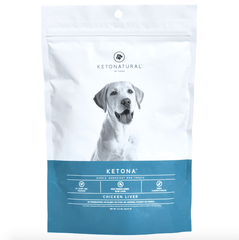Save Money, Save Your Dog.
Join Our Email List For Discounted Pricing and a Free Guide to the Science of Keto Dog Food.
The Science of Dehydration in Dogs
All mammals require adequate hydration to maintain optimal functioning in a number of the body’s most important systems. For starters, it helps us to remove toxins from the body. Additionally, almost all metabolic reactions -- the events through which nutrients are converted into fuel in the bloodstream -- occur in the presence of water. And, of course, adequate hydration is necessary for optimal thermoregulation. Although perspiration plays little to no role in canine thermoregulation, panting and drooling are critically important, and water is key to both processes.
Dehydration is a deficiency of water within an organism. It occurs when the amount of water expelled from the body as perspiration or urine outpaces the amount consumed for a sufficiently lengthy period of time. Thus, to avoid dehydration an organism must consume water at a rate roughly concurrent with the rate of loss. It’s all about balance -- if you sweat heavily for a prolonged period of time, you must consume water at a relatively high rate to avoid dehydration. If you’re not sweating, you don’t need to drink as often.
Any condition which raises the rate at which water is emitted from the body will result in dehydration if water is not consumed at a correspondingly high rate. So, when monitoring your dog for dehydration, be mindful of conditions which cause panting and drooling, such as hot environments and bouts of intense physical activity, as well as any illness resulting in fever, vomiting, or diarrhea. To avoid dehydration, dogs will need to consume water at a relatively rapid pace in such conditions.
Because water is so important to a dog’s thermoregulatory functions, dehydration compromises a dog’s ability to cool itself down. As a result, persistent dehydration may lead to serious heat-related maladies such as heat cramps, heat exhaustion, and heat stroke. Heat stroke is a particularly dangerous condition in which core body temperature rises to 105F and above and internal organs begin to break down. It kills hundreds of dogs every year.
Signs and Symptoms of Dehydration in Dogs
The signs of canine dehydration include:- Dry, sticky tongue and gums.
- Lack of skin elasticity. Check for this by gently pinching some skin off your dog’s back. If it doesn’t spring quickly back into place when released, it’s likely a sign of dehydration or some other illness.
- Dry nose.
- Sunken eyes. This can be difficult to spot because the change is subtle. Compare the appearance of your dogs eyes with your memory of their healthy, normal appearance. If something seems “off,” your pup may be experiencing dehydration.
- Lethargy and lack of energy.
- Tremors, convulsions, or vomiting.
- Reddish or bluish gums.
Naturally, the best way to avoid dehydration is to keep lots of fresh, clean water available. The proper amount varies dog-to-dog and is highly dependent upon external conditions. If your dog displays any of the foregoing symptoms in connection with any of the external conditions described above, be smart and seek veterinary care immediately. A dehydrated dog likely will require more fluid than he can drink on his own.
Now go out there and safely enjoy the beautiful summer weather!


Related Articles
How Much Does The Farmer’s Dog Really Cost?
5 Signs and Symptoms That Your Dog May Have Diabetes
Learning to Take Pleasure In Being Your Dog's Play Buddy-Drill Sargeant
Dogs, Dog Food and Dogma - A Book About America's Pet Obesity Epidemic
Browse Articles By Category